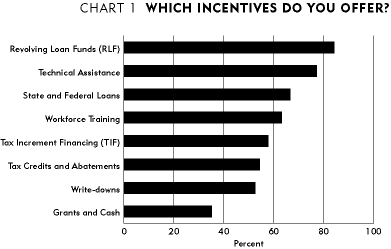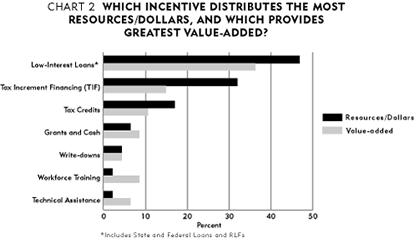The toolbox, a handyman's place for things to finish a tough job. Different jobs demand different tools, but a toolbox puts everything at your fingertips in case your needs change.
The toolbox is an apt metaphor for business incentives given by local development organizations, according to a recent survey conducted by the Minneapolis Fed. The survey found that organizations typically have access to a number of incentive tools and programs, using them differently (sometimes in combination) to meet the unique needs of each company interested in expanding in their community (see Glossary).
"A community needs a toolbox of incentives because flexibility is important," said Ron Kraft, executive director of the Yankton (S.D.) Office of Economic Development. "In any (business) expansion location decision, there are always problems and competitive disadvantages that need to be offset. Incentives are often the way to close the gap and the deal. My frustration is that incentives have often become part of the opening of the deal as opposed to the way to close a deal."
To gauge the use of business incentives and check the pulse of competition among cities for expanding businesses, the Minneapolis Fed e-mailed a survey to 260 economic development professionals in the Ninth District. A total of 57 usable responses were received via e-mail or fax, representing mostly public, quasi-public and nonprofit organizations involved in economic development on behalf of cities, counties and regions.
Due to factors of survey sampling and question methodology, this survey is not, and should not be considered, scientific in its conclusions. However, given the volume of input, the survey provides a useful snapshot of the tools local development practitioners are using, and why.
And the winners are ...
Given different tax and regulatory structures, most states and local communities have different sets of incentives available to them. However, there are general incentive categories that encompass myriad offerings in different locations. For example, most states provide tax credits or abatements to attract new businesses, but each program is unique from the other (to use the toolbox analogy, every toolbox has a hammer; some have a Craftsman, others an Estwing).
Using a list of eight general incentive categories (see chart 1), the survey found that development organizations are going to the toolbox often to find the right tool to close a deal, and some tools are used more often than others. Of the eight incentive tools, more than half reported using six or more at least once, and 85 percent reported using at least three different tools to assist local development efforts.

Source: Federal Reserve Bank of Minneapolis
Tops on the list of most-used incentives are revolving loan funds (RLF), which were used by about six of seven respondents.
Flexibility was the RLF's biggest asset, respondents said. Marc Nevinski, acting assistant director of development for the city of Elk River, Minn., said that loan programs are an "easy tool to use, and they have broader applications than TIF [tax increment financing]."
Flexibility also applied to how loan funds can be used. Loans coordinated by Mountrail County (N.D.) Job Development Authority often are used for working capital and development of marketing materials, according to director Jonathan Scott. "In our part of the world, these are the most difficult [but] essential business functions to finance through conventional finance institutions," Scott said.
Low-interest loan programs—RLFs as well as state and federal loan programs—were also cited by development professionals as the tool that distributed the most money (see chart 2).

Technical assistance was provided by almost four in five respondents. Technical assistance can be relatively inexpensive depending on the nature of the service provided, and tends to be popular among businesses in some smaller communities simply "because it's available," according to one South Dakota respondent. A Montana practitioner noted that technical assistance was popular because "it is required [by] every other tool we have."
Survey respondents also indicated that certain incentives would likely be more popular if greater resources were dedicated to them. Russ Staiger, president of the Bismarck-Mandan (N.D.) Development Association, said he would like to use an interest buy-down program in his state more often, "but because of its popularity, it is not uncommon to run out of [money] before the end of the biennium."
Grants and direct cash payments were used by fewer than half of respondents, but apparently not by choice. A number of people wished they had greater access to grant money, as most organizations lack the internal resources to provide grants, and there is hot competition for a limited pool of state and federal grants.
The MVP of incentives
Low-interest loans were also the tool with the greatest value-added, according to the survey. "The funds stay in the community and can often be treated as 'near capital' that is often not available in small rural communities," said James Davidson of Anaconda (Mont.) Local Development. "Money seems to be around for the hot idea of the day, but [money for] the day-to-day businesses that keep a community going is often more difficult to acquire."
"The low-interest loan program is a win/win for the community and business," said Scott. "We are able to grow and revolve taxpayer dollars and provide local businesses with money that they can use to leverage dollars with their financial institutions and other public funding institutions."
But there were a few fans for almost every incentive. Some said tax abatements provided the greatest payoff for cities and recipient businesses. Although tax abatements and credits contribute little to the local tax base in the short run, other benefits like new jobs still make them a valuable tool. "We tend to look at tax abatements as half of something where nothing existed before," said Jeff Ratcliffe, executive director of the Luce County Economic Development Corp. in Michigan's Upper Peninsula (U.P.).
The Renaissance Zone program in Michigan has created a number of virtually tax-free areas in the U.P., thanks to generous tax credits. But to some, it's better than the alternative of no activity. "These areas are typically providing little or no tax base currently and create little local hardship when compared with the jobs created," said Mike Gokey, director of economic development for the Lake Superior Community Partnership in Marquette, Mich.
While only four respondents identified workforce training as providing the greatest value, it might be partially due to the relatively meager resources dedicated to it. One Montana practitioner said his organization was trying to create its own program in light of the state's absence in this area. Brian Tohal of the New Ulm (Minn.) Economic Development Corp. believed that the state "should be as concerned about skill growth as job growth" because greater skills are what ultimately lead to higher wages for workers.
"Skill growth should be the keystone of economic development policy and practice," Tohal said, but added that Minnesota's current approach to workforce training was "dysfunctional and difficult to access and severely underfunded."
Competition fierce, cooperation stops at state lines
Competition was also a hot topic among respondents. Most agreed that competition was fierce, particularly from other states. Some, in fact, have been held hostage over the competition.
Practitioners were asked if incentives have been provided in response to a competing offer from another community, or a company's threat to leave. Of those who responded to the question, 40 percent indicated such an occurrence had happened at least once in the last five years—with some seeing significantly greater competitive pressures.
Tohal estimated that "80 percent of business agreements in the last five years included incentives specifically because [companies] threatened to move or received an offer from a competing community." One respondent from Oneida County, Wis., put the figure at 50 percent.
Most of the competition comes from communities in other states. In fact, cooperative efforts among neighboring cities appear to be fairly common among respondents. "The unwritten code of ethics among [economic development] professionals is that you do not cherry pick a neighboring community's businesses," Tohal said.
Scott of Mountrail County noted that if he does not have the resources to close a deal, he can approach other local communities for assistance "knowing that they won't try to take the project." In return, Scott said, "if I can't provide what the company wants, I will pass the lead on to them."
But not every place enjoys such an all-for-one, one-for-all attitude. Several different development organizations in St. Louis County (Minn.) are trying to get cities to understand that "what is good for one will be good for all," according to Connie Christenson, a representative of the county community development division. "The task is not easy. Traditional parochial barriers still remain but the walls are not quite as high."
What's more, that code quickly evaporates at state lines, according to numerous comments. "Cherry picking from other states seems to happen more often, or is not as taboo," Tohal said. "Our manufacturing companies regularly show us invitations from communities in neighboring states inviting them to relocate."
The same was true for James Anderson, executive director of the Schoolcraft County (U.P.) Economic Development Corp. "Existing companies and prospects will regularly point out incentives available in other states, even if they are not seriously considering the other state, in order to try and get us to increase an offer."
A number of respondents commented that rural communities were at a competitive disadvantage when it came to business incentives. Oftentimes it's a matter of money and other resources. "Many small communities like ours have such limited resources," said Tom Lovik, economic development coordinator in Wishek, N.D. "It's hard for us to compete with larger cities that may have hundreds of thousands of dollars to toss on the table as incentives."
In some cases, the design of incentive tools favors larger urban areas. For instance, the Michigan Economic Growth Authority (MEGA) is a tax credit program available to existing companies that are creating 75 or more jobs, or to new companies bringing 150 new jobs.
"For rural areas like ours, it is difficult to meet job creation criteria," said Linda Hirvonen, executive director of the Delta County (U.P.) Economic Development Alliance. "We have very few companies who employ over 100" people, much less hire 100 new workers, she said.
Al Roder, executive director of Becker County (Minn.) Housing and Economic Development, said he faces a similar dilemma. "I would like to use state programs more extensively but the guidelines are too stringent. In rural [Minnesota], most of our projects are creating 10 or fewer new jobs. [The] state is interested in funding mostly 100-plus projects, [which] works against entrepreneurship explosion we are finding in greater Minnesota."
Some also charged that growing regulations on business incentives was a disservice to rural areas. "The more regulation placed on the delivery of incentives, the greater the advantage to larger metropolitan communities who have larger economic development staffs to deal with it," said Tohal. "If regulation is to be fair to all communities it must be simple to administer."
Opinions about regulations were especially strong among Minnesota respondents, who are forced to comply with one of the strongest incentive reporting laws in the country. David Black, economic development coordinator of the West St. Paul Economic Development Authority, called the law "vague and unworkable."
"Limiting unnecessary public support of private businesses is a laudable goal, but you can't restrict business subsidies-however defined-by putting more conditions on them," Black said. "Businesses will pit cities against one another to get what they want, and the public will insist that the city step forward to keep [or] attract a good company."
Ron Wirtz is a Minneapolis Fed regional outreach director. Ron tracks current business conditions, with a focus on employment and wages, construction, real estate, consumer spending, and tourism. In this role, he networks with businesses in the Bank’s six-state region and gives frequent speeches on economic conditions. Follow him on Twitter @RonWirtz.





